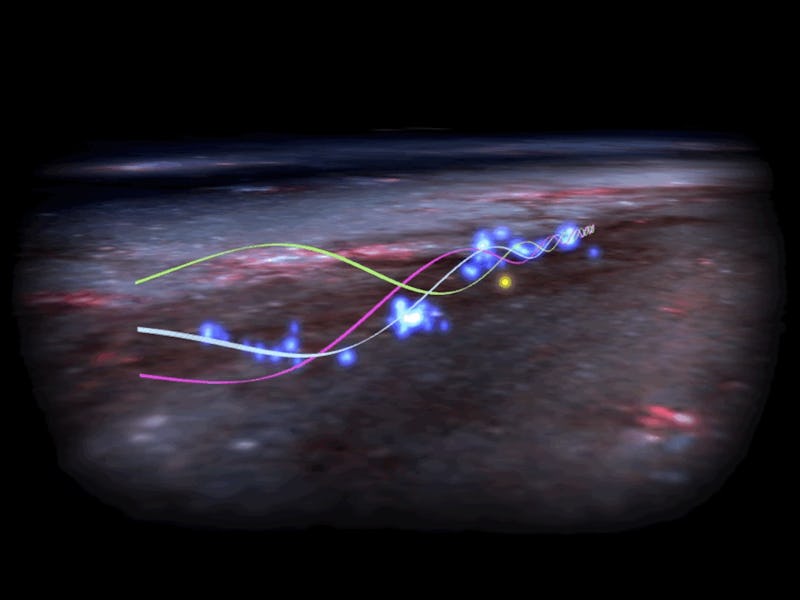A Backbone Holding Up the Milky Way Is Bending — And Astronomers Don't Know Why
The nearby Radcliffe Wave is in motion, a new study reveals.

The dusty backbone of our spiral arm of the Milky Way is waving.
We live near the end of a long, thin stream of gas, dust, and stars, which spirals outward from the center of the Milky Way. Our cosmic neighborhood is called the Orion Spur, and it’s sort of like a stellar side street between the main pair of spiraling “arms” that give the Milky Way its trademark pinwheel shape. The backbone of the Orion Spur is a chain of dense gas clouds called nebulae, and all along that chain of nebulae, clumps of gas are collapsing into clusters of bright new stars.
This sparkling chain of gas clouds and newborn star clusters is called the Radcliffe Wave, because when astronomers mapped it in 2020, it traced an undulating shape, like the graph of a sine wave. It stretches 9,000 light years along the Orion Spur, and it passes just 500 light years from the Sun at its closest point. According to a recent study, it’s not just wave-shaped: It’s moving up and down.
Harvard University astronomer Ralf Konietzka and his colleagues published their work in the journal Nature.
This illustration shows a simulated version of the Radcliffe Wave in motion.
Doing the Wave
Using data from the European Space Agency’s Gaia space telescope, [authors] tracked how the bright young star clusters within the Radcliffe Wave were moving — in all three dimensions. The stars’ motion revealed that the whole Radcliffe Wave was oscillating up and down. Konietzka and his colleagues compare the stars’ motion to fans doing “the wave” in a packed stadium.
The discovery suggests that galaxies, along with their scaffolding of gas and dust, may be more full of motion than we realized.
Astronomers have only known about the existence of the Radcliffe Wave since 2020 when a team led by João Alves at Harvard University used an earlier set of Gaia data to map young star clusters and dense clouds of dust that make up the immense, sinuous structure. Alves and his colleagues named the wave after the Radcliffe Institute for Advanced Study at Harvard (not Daniel Radcliffe; we were disappointed to learn that, too). Gas, dust, and stars adding up to more than three million times the mass of our Sun, stretch along a 450-light-year-wide, 9,000-light-year-long string, whose wavy path through space looks like it’s tracing the topography of gently rolling hills.
But back in 2020, the data Alves and his colleagues were working with wasn’t detailed enough for astronomers to tell whether the Radcliffe Wave was moving, or if it just happened to be shaped like a sine wave frozen in place. With the new, higher-resolution data, Konietzka and his colleagues – including Alves and several of the other researchers who discovered the Radcliffe Wave – can now see that the Radcliffe Wave is actually waving.
What Set the Radcliffe Wave in Motion?
Astronomers still aren’t sure exactly why the stars and gas of the Radcliffe Wave are moving like fans in a sports stadium, or how the huge natural structure formed in the first place.
“Theories range from explosions of massive stars, called supernovae, to out-of-galaxy disturbances, like a dwarf satellite galaxy colliding with our Milky Way,” says Konietzka. Those kinds of events could have shaped the nebulae and star clusters into the strip that forms the backbone of the Orion Spur, and they could also have provided a gravitational nudge to set the whole thing into rippling motion.
Unlike most questions involving large natural structures in space, the answer here doesn’t seem to involve dark matter. In Konietzka and his colleagues’ simulation, ordinary visible matter was more than capable of driving the strange motion of the Radcliffe Wave.
The discovery also raises larger questions about the large filaments of gas and dust that make up the scaffolding of galaxies. Does every spiral arm in our galaxy (and in other spiral galaxies) have a similar network of nebulae running along its spine? And do all of them “do the wave”? If so, is that waving a temporary response to a disturbance, like a close call with a passing dwarf galaxy, or is it constant for reasons we don’t yet understand?
More data, from Gaia and possibly from JWST — which other astronomers have already used to study the networks of dust and cold gas in nearby galaxies — may help answer some of those questions.